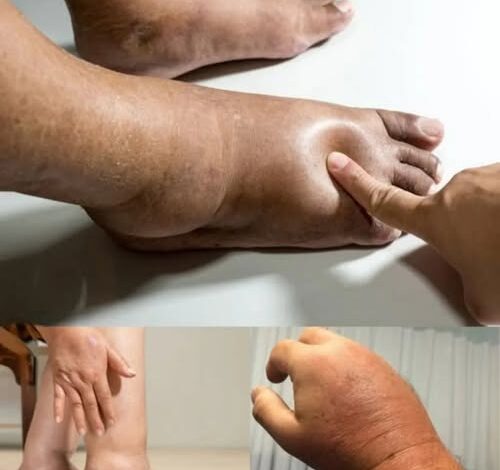
If your feet and hands are swollen, here is what your body is trying to tell you
Swelling in the hands and feet is a common issue that can range from mildly uncomfortable to genuinely concerning. Sometimes it’s just a temporary problem caused by standing too long, sitting in one position, or being out in hot weather. Other times, it can be linked to hormonal changes, circulation issues, or underlying medical conditions. While persistent or severe swelling should always be checked by a doctor, lifestyle changes—including what you eat—can make a real difference. Certain foods help regulate fluid balance, support circulation, and reduce inflammation, offering natural relief from swelling and discomfort.
The Role of Potassium
Potassium is one of the body’s most important minerals for maintaining fluid balance. When potassium levels are too low, the body tends to hold onto sodium, and excess sodium leads to water retention and swelling. Bananas are famous for their potassium content, but they’re not the only option. Avocados, oranges, sweet potatoes, beans, and lentils are also excellent sources. Regularly including these foods in your diet helps the body flush out excess sodium, which in turn reduces swelling and supports healthier blood flow.
Hydrating Fruits and Vegetables
Hydration is key to preventing swelling, and drinking enough water is only part of the solution. Many fruits and vegetables act as natural hydrators because of their high water content.
Cucumbers are over 90% water and contain compounds that support connective tissue health. Adding them to salads, snacks, or even water not only refreshes but also helps combat puffiness.
Watermelon is another powerhouse. Not only is it hydrating, but it also acts as a mild diuretic, encouraging the body to release excess fluid. Packed with antioxidants like lycopene, watermelon also fights inflammation, making it especially helpful during hot weather or after a long day on your feet.
Citrus fruits such as oranges, lemons, and grapefruits also provide hydration along with vitamin C, which strengthens blood vessels and reduces fluid buildup.
Leafy Greens for Circulation
Spinach, kale, and Swiss chard are rich in both magnesium and potassium—two minerals critical for fluid regulation and vascular health. Magnesium in particular helps relax blood vessels, improving circulation and lowering the pressure that can contribute to swelling. Adding greens to smoothies, omelets, or salads is an easy way to reap these benefits daily.
Antioxidant Powerhouses
Antioxidant-rich fruits can also help. Berries—such as blueberries, strawberries, and raspberries—contain anthocyanins, compounds that strengthen blood vessels and reduce inflammation. This not only helps ease swelling but also supports long-term cardiovascular health.
Pineapple offers a unique edge thanks to bromelain, a natural enzyme with strong anti-inflammatory properties. Athletes often use bromelain supplements to recover from injuries or reduce swelling after intense activity. Eating fresh pineapple can bring similar benefits for everyday swelling in the hands and feet.
Natural Diuretics and Healing Spices
Certain foods encourage the body to shed excess water naturally, acting as gentle diuretics.
Celery helps flush sodium and water from the system while also delivering fiber to improve digestion and reduce bloating.
Spices such as ginger and turmeric are known for their anti-inflammatory and circulation-boosting effects. Adding grated ginger to tea or turmeric to curries, soups, and stews can help calm the inflammatory processes that contribute to swelling.
Parsley, often overlooked, is another mild diuretic that can be added fresh to salads or smoothies for an extra boost.
Healthy Fats and Seeds
Nuts and seeds should not be forgotten in an anti-swelling diet. Almonds, walnuts, flaxseeds, and pumpkin seeds provide omega-3 fatty acids, magnesium, and vitamin E—all nutrients that reduce inflammation and support blood vessel health. Regular consumption helps improve circulation and lowers the risk of cardiovascular problems that often accompany chronic swelling.
Olive oil and fatty fish like salmon and sardines also provide anti-inflammatory omega-3s, making them excellent additions to meals.
Practical Tips for Daily Relief
Diet plays a big role in reducing swelling, but small daily habits can also help. Avoiding overly salty processed foods is crucial, as excess sodium directly triggers fluid retention. Elevating your legs at the end of the day, wearing comfortable shoes, and taking breaks from prolonged standing or sitting also ease the burden on your circulation. Drinking plenty of water throughout the day ensures your body doesn’t hold onto fluid unnecessarily.
Final Thoughts
Swollen hands and feet can have many causes, from diet and lifestyle to medical conditions, but food choices offer a simple, natural way to find relief. Potassium-rich fruits and vegetables help balance fluids, antioxidant-packed berries and pineapple strengthen blood vessels, and spices like ginger and turmeric calm inflammation. Nuts, seeds, and healthy fats further support circulation and overall vascular health.
It’s important to remember, however, that if swelling is persistent, painful, or sudden, you should consult a healthcare professional to rule out underlying conditions such as heart, kidney, or liver issues. Still, by making thoughtful changes to your diet and lifestyle, you can significantly reduce swelling, ease discomfort, and support better overall well-being.
In the end, the path to feeling lighter and healthier may start with something as simple as what you put on your plate.




